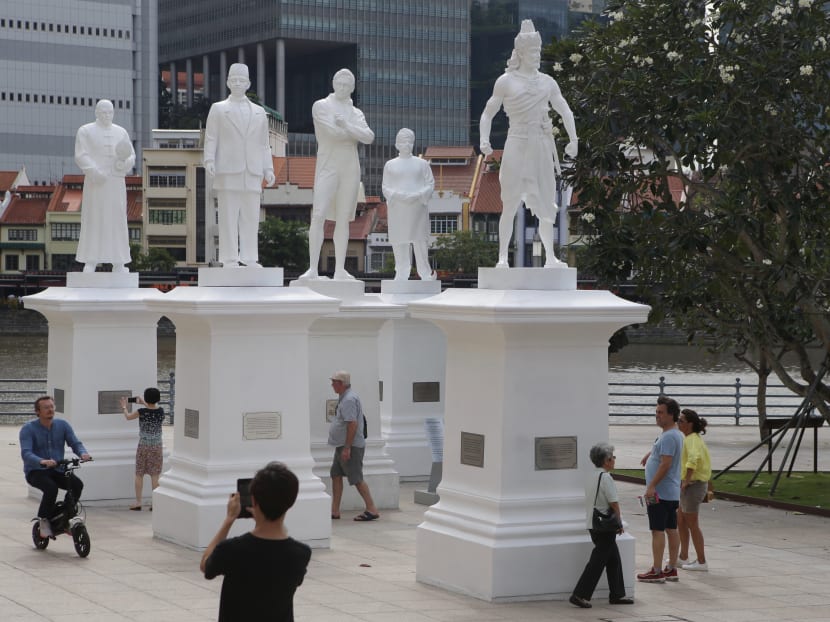Reimagining Singapore’s history through storytelling
“Singapore’s history does not have to be monolithic, state-driven and textbook-based. Let’s see it as a collection of stories about people who call Singapore home – stories we can all relate to,” says the author.

Statues of Sang Nila Utama, Tan Tock Seng, Munshi Abdullah and Naraina Pillai placed temporarily beside the statue of Sir Stamford Raffles along Singapore River on January 4, 2019 as part of the Singapore Bicentennial celebrations.
What comes to mind when you think of Singapore’s history? Do you think of the landing of Sir Stamford Raffles, World War II, the separation of Singapore and Malaysia, or a historical fact you picked up from a textbook?
Though these major events shaped Singapore into the modern city state we know today, not everyone relates to macro, historical narratives, or identifies with them at a personal level.
This is perhaps why some have cast doubt on commemorating the Singapore Bicentennial, and expressed scepticism at the relevance of Singapore’s past prior to independence in 1965.
We need to shift our mindsets. Singapore’s history does not have to be monolithic, state-driven and textbook-based. Let’s see it as a collection of stories about people who call Singapore home – stories we can all relate to.
FIND PERSONAL MEANING IN HISTORY
Singapore’s identity has changed over the centuries, shaped by the flows of trade, people and ideas.
Read also
To truly appreciate where we are today, how far we have come, and how much further we can go forward together, we have to understand how complex and rich our history is.
Our country’s history stretches beyond 1819, when the arrival of Sir Stamford Raffles marked the start of modern Singapore.
Growing evidence unearthed by historians and archaeologists points towards Singapore’s status as a thriving port city, Temasek, in the 14th century, and sheds light on the diverse communities who have inhabited the island since.
When solely presented in this manner, I can understand why Singapore’s history does not automatically strike a chord with everyone.
So how can we make history more accessible and meaningful, and get more people in Singapore, especially youth, interested in our past?
By telling stories. Stories that resonate with us, that allow us to find personal meanings in history. Stories reimagined by young people in Singapore of love, loss, self-discovery and identity. Stories not everyone has heard before.
Read also
ENGAGE WITH HISTORY THROUGH STORYTELLING
Throughout our history, different people and communities have joined the Singapore journey or left a mark on our country.
Many are everyday individuals — from the hawkers who plied their wares at Sungei Road Thieves Market before it closed, to factory women in the 1970s who paved the way towards Singapore’s economic success.
As Prime Minister Lee Hsien Loong mentioned at the launch of the Singapore Bicentennial last month, the stories of these communities are the personal experiences and collective memories that give life and meaning to the Bicentennial story.
The Bicentennial could therefore help people find personal meaning in history through lesser-known stories that give voice to communities who might have been left out of the broader historical narrative.
As a nation, we need to make a concerted effort to tell these stories through fresh and creative means, which allow people — young and old — to experience history in more engaging ways. This is how we can ignite a renewed interest and spark conversations around our past.
UNCOVER LESSER-KNOWN STORIES THROUGH THE BICENTENNIAL
Over 200 groups and organisations are holding commemorative events for the Bicentennial, presenting many opportunities for people to rediscover Singapore’s history.
One of the initiatives is The Future of Our Pasts Festival, an arts and media festival organised by Yale-NUS College that uncovers lesser-known stories of Singapore’s communities and places.
Read also
The month-long festival features creative projects by young artists and cultural advocates, allowing audiences to reimagine Singapore’s history through interesting mediums, such as performances, exhibitions, films, graphic novels, and a web documentary.
The festival will tell stories from Singapore’s past and present through the lens of our youth. Many of them have drawn from their personal experiences, stories, and passions, lending a fresh voice to history.
For example, one of the showcased projects is ‘Rojak Romance’, a documentary exploring the history and identity of the Ceylonese Tamil community, narrated from the perspective of the two film-makers, a mixed-race couple.
Meanwhile, the director of ‘First Storeys’, a theatrical installation, was inspired by his grandparents’ experience of housing resettlement in the 1970s and in 2015.
As Singapore kicks off its Bicentennial to trace 700 years of our colourful history, it is an opportune time for us to explore the different dimensions and complexities of our past.
By telling lesser-known stories that resonate with people in Singapore, I believe we can all find meaning and relevance in history, and engage with our past in interesting ways.
ABOUT THE AUTHOR:
Professor Tan Tai Yong is President and Professor of Humanities at Yale-NUS College, Member of the Singapore Bicentennial Advisory Panel, and Chair of the Steering Committee for The Future of Our Pasts Festival, which runs from Feb 16 to March 17.









